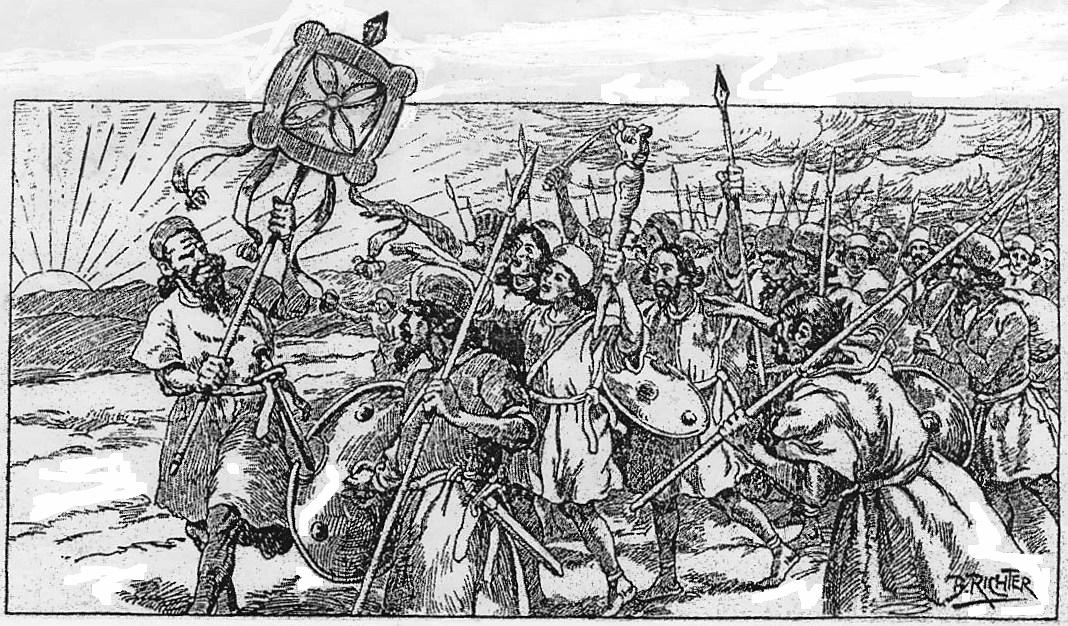The First Flag of Iran

Laleh Hotel
May 30, 2021
Ariana Traditional Hotel
July 17, 2021The First Flag of Iran and The Legend of Kave
In popular usage “myth” is equated with something being false or illusory. In the study of religion, in contrast, myths are seen as narratives that encapsulate fundamental truths about the nature of existence, God(s), and the universe. They explain the origin of the world of a tribe or of a ritual.
They concern life after death, embody an understanding of right and wrong, and convey messages of salvation or damnation. Myths are commonly thought to make past events or forces “really” present, especially when acted out in ritual. They are therefore sources of spiritual power. The origin, function, and legitimation of rites are commonly contained in myths.

Typologies have value, but commonly myths are conditioned by the culture in which they emerged, and to whose formation and development they have often contributed. Legends are stories that are seen to have a basis, however remote, with people who are thought to have lived on earth in historical times, though they often portray abstract ideas about valor, good heroes, and wicked tyrants. The distinction between myth and legend can in practice be difficult to identify. The Legend of Kaveh is linked with the thought and desires of Iran’s people, as well as their legends and fatherland.

Iran‘s legendary history is of great importance. The colloquial conveyance of a legend is rooted in social behavior rather than in the individual one. Kaveh was not mentioned in the religious literature of Pahlavi at all and has no legendary antiquity. The history of Kave the Blacksmith was described in the holy “Avesta” and later retold in “Shahname” by Ferdowsi poet… It seems that this legend has been created after the Ashkanid era and engraved in the legendary history of the Sasanid era. The Legend of Kaveh, as a symbol of a victorious rebellion, is a reminder of those people who desire to change their destinies. In Iranian mythology, Kave was a blacksmith that led an uprising against the ruthless foreign ruler Zahak, who had seized the throne.
In “Shahname” it is told that Kave had eighteen sons and seventeen of them fell victim to a monstrous snake growing up from the shoulders of the tyrant Zahak. When the snake finished eating the head of the seventeenth son and was getting ready to attack the last one, the blacksmith went to the palace for justice. Zahak, to protect his rights to the throne, wrote regulations about his justice. He listened to the blacksmith’s complaint demonstratively and calmly and released his last son asking him to sign the regulations.
The double game of Zahak made Kave mad. He threw the letter and ran away with his son from the palace. Kave, attaching his leather apron to the spear, gathered people and lead them to Fereydun, the ruler by right. Thus, the first flag of the Iranian people was created. Fereydun got inspired by the flag and decorated it with a golden star with four rays, ribbons of red, yellow, and purple colors, and precious stones. He called the flag “Derafsh Kavian” (the flag of Kave). The rebels, the blacksmith, and Fereydun overthrow Zahak and got back the throne.
Also the First Men & Heroes in Iranian Myths
Kyumars, meaning mortal, is the first legendary man who is described as handsome and attractive man and as bright as the Sun. It is believed that he has been born out of the earth.
Hooshang is the first king founding the first legendary dynasty of Iran called Pishdadian. He promotes civilization in the world, exploits iron, uses ironsmith techniques, produces and uses tools and weapons, etc.
Jamshid is the greatest hero who is introduced as the king of the whole world. Everything is good during his ruling period.
Fereydoon, another king, is always remembered for his struggle against Zahak. He does not kill him but imprisons him forever in Mount Damavand.
Rostam is one of the greatest mythical heroes in Shahnameh. He turns out to be the symbol of physical as well as spiritual power and devotion to his country. He is such a strong man who can defeat an elephant instantly with his mace.
Rakhsh is Rostam’s horse and the only horse whose belly does not reach the ground when Rostam presses his hand on its back. So, it is chosen by him to be his faithful servant. It passes through all hardship and battles along with Rostam and eventually dies with him.
Sohrab is Rostam’s son who grows up to be a strong brave young boy. His father, who does not know his son before giving him the last deadly blow, ultimately kills him.
Siavash is a prince who learns all the techniques and skills of princedom from Rostam. Since he refuses to answer positively to the temptations of his father’s wife, his father wants him to pass through the fire to prove his innocence. This was a pre-Zoroastrianism tradition. At last, he becomes the victim of Garsivaz’s intrigues and is killed in an innocent death.

